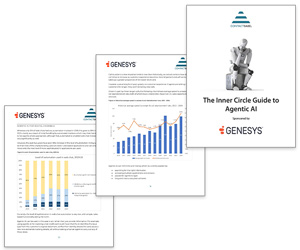SMS doesn’t always get the attention it deserves.
With flashier channels like WhatsApp, webchat, and in-app messaging hogging the limelight, you’d be forgiven for thinking outbound SMS was a relic of the past… But when used well, it’s still one of the most reliable, personal, and cost-effective tools in your customer engagement kit!
Whether you’re just getting started or brushing up on the basics, this quick guide will walk you through what outbound SMS actually is, how it works, when (and when not) to use it, and a few top tips to help you hit the ground running.
What Is Outbound SMS?
Outbound SMS is exactly what it sounds like: text messages sent outbound, from a business to a customer.
Think appointment reminders, delivery updates, security alerts, or even quick feedback requests. It’s proactive communication, often automated, that goes directly to a customer’s mobile phone – no app needed, no internet required.
The beauty of SMS lies in its simplicity. It’s direct, doesn’t rely on Wi-Fi, and (unlike email) doesn’t usually get lost in a promotions folder or spam filter. People check their texts – and they tend to open them fast. We’re talking minutes, not hours.
But how do you actually offer SMS as a channel?
How It’s Offered (and Where It Sits in the Tech Stack)
Most modern contact centre platforms, such as Genesys Cloud CX, offer outbound SMS as standard.
In practice, that means it can sit right alongside your voice, email, live chat, and social media comms – giving agents a single view of the customer journey across every touchpoint.
Let’s take Genesys as an example. You can set up SMS outbound campaigns directly in the platform.
That means you can automate messages to go out based on:
- Set triggers (like a missed call or a scheduled delivery) or
- As part of a broader campaign (e.g. reminding customers about expiring policies or alerting them to a service outage).
In some cases, outbound SMS might be used purely for information sharing.
In others, it might be more interactive – allowing the customer to reply, update their details, or even self-serve by following a link to your website or chatbot.
That’s where it gets really powerful.
When to Use Outbound SMS
Outbound SMS tends to shine in these key areas:
Retail and Logistics
You’ve probably had these yourself – “Your parcel will be delivered between 10:30 and 12:00” or “Your item is ready for collection”.
These short, sharp messages reduce the likelihood of failed deliveries and give the customer confidence in the process.
Healthcare
Missed appointments are costly for everyone. GP surgeries, hospitals, and dental clinics can use outbound SMS to confirm bookings, send pre-appointment instructions, and remind patients to attend.
Financial Services
In an industry where trust is everything, speed matters. From suspicious activity alerts to bill payment reminders, banks and lenders can use SMS to keep customers in the loop – without the faff of logging into a portal.
Utilities
If there’s one thing no one wants to find out after the fact, it’s a power cut or water outage. Utility companies often use SMS to keep customers informed during maintenance or emergencies – and to follow up afterwards with satisfaction surveys or compensation information.
If you are looking for more advice to help improve CX across verticals, read our article: An Introduction to… CX Across Vertical Markets
Where You Shouldn’t Use Outbound SMS
These are some of the no-nos (in any industry) as to when you shouldn’t be using outbound SMS:
Sensitive or Complex Conversations
If the issue is nuanced, emotional, or needs a lot of back-and-forth, a call or video chat is probably better. SMS lacks tone, and no one wants to explain their life story in 160 characters.
When You Don’t Have Consent
This one’s a biggie. Under GDPR and other privacy laws, you need clear permission to contact someone via SMS. Don’t skip this step – or you could face fines and annoyed customers.
High-Stakes Security Information
Although SMS is pretty secure for basic alerts, it’s not the place to share things like PINs or full account numbers. Use it to prompt action (“Log in to check your statement”) – not to reveal sensitive data.
5 Top Tips for Outbound SMS
Decided it’s the right channel for your customers? Here’s some best-practice advice to help you succeed:
1. Keep It Snappy
You’ve got 160 characters – use them wisely. Get to the point fast, avoid jargon, and write like a human. Bonus points for including a call to action, such as “Tap here to reschedule”.
2. Personalize Where You Can
Even small touches – like using the customer’s name or referencing their specific appointment – can make a big difference. No one wants to feel like they’re just a number.
For more advice on personalization, read our article: 21 Steps to a More Personalized Customer Experience
3. Timing Matters
Avoid sending texts too early or too late (especially for sectors like healthcare). Mid-morning to early evening tends to be the sweet spot.
4. Offer a Way to “Opt Out”
This is a legal requirement, but it’s also just good customer service. You really don’t want customers on your list who find your texts annoying. Something like “Reply STOP to unsubscribe” keeps things clean and compliant.
5. Test, Tweak, Repeat
Don’t just set and forget. Test different messages, timings, and formats to see what gets the best response – and keep refining as you go.
Outbound SMS Can Quietly Solve Problems Before They Escalate
SMS isn’t shiny. It’s not AI or the newest kid on the block. But what it lacks in glamour, it more than makes up for in reliability, reach, and results.
When used thoughtfully, especially as part of a wider comms strategy, it can quietly solve a lot of problems before they escalate.

As Katie Stabler, CULTIVATE Customer Experience by Design and author of CX-Ism: Re-Defining Business Success, says:
“While many organizations cling to traditional service channels, perhaps out of habit or caution, the real differentiators are those who choose channels based on customer preference – not operational convenience.“
The chances are you probably already have the tech available within your existing platform too! It’s just a case of plugging in the strategy.
So, start small, focus on customer value, and treat each message like it matters (because it does). And who knows? That little text might just be the thing that turns an unhappy customer into a truly grateful one.
If you are looking for more information on outbound and customer correspondence, read these articles next:
- How to Nail Your Outbound Strategy
- The 7 Cs of Effective Communication
- Stay on Top of Social Media Like a CX Pro
Author: Stephanie Lennox
Reviewed by: Megan Jones
Published On: 4th Nov 2025
Read more about - Technology, Customer Service, Genesys, Katie Stabler, Outbound, Personalization, Service Strategy, Stephanie Lennox, Technology Enablement Strategy, Technology Roadmap, Top Story









































